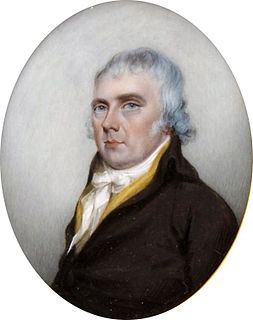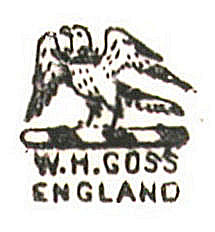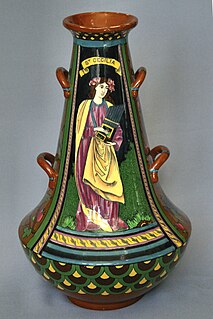
Porcelain is a ceramic material made by heating substances, generally including materials such as kaolinite, in a kiln to temperatures between 1,200 and 1,400 °C. The strength, and translucence of porcelain, relative to other types of pottery, arises mainly from vitrification and formation of the mineral mullite within the body at these high temperatures. Though definitions vary, porcelain can be divided into three main categories: hard-paste, soft-paste and bone china. The category that an object belongs to depends on the composition of the paste used to make the body of the porcelain object and the firing conditions.

Clarice Cliff was an English ceramic artist and designer. Active from 1922-to 1963, Cliff became the head of the factory creative department.

Josiah Spode was an English potter and the founder of the English Spode pottery works which became famous for the high quality of its wares. He is often credited with the establishment of blue underglaze transfer printing in Staffordshire in 1781–84, and with the definition and introduction in c. 1789–91 of the improved formula for bone china which thereafter remained the standard for all English wares of this kind.

Bernard Palissy was a French Huguenot potter, hydraulics engineer and craftsman, famous for having struggled for sixteen years to imitate Chinese porcelain. He is best known for his so-called "rusticware", typically highly decorated large oval platters featuring small animals in relief among vegetation, the animals apparently often being moulded from casts taken of dead specimens. It is often difficult to distinguish examples from Palissy's own workshop and those of a number of "followers" who rapidly adopted his style. Imitations and adaptations of his style continued to be made in France until roughly 1800, and then revived considerably in the 19th century.

Spode is an English brand of pottery and homewares produced by the company of the same name, which is based in Stoke-on-Trent, England. Spode was founded by Josiah Spode (1733–1797) in 1770, and was responsible for perfecting two extremely important techniques that were crucial to the worldwide success of the English pottery industry in the century to follow.

In different periods of time and in different countries the word majolica has been used for two distinct types of pottery.

Bone china is a type of ceramic that is composed of bone ash, feldspathic material and kaolin. It has been defined as "ware with a translucent body" containing a minimum of 30% of phosphate derived from animal bone and calculated calcium phosphate. Bone china is the strongest of the porcelain or china ceramics, having very high mechanical and physical strength and chip resistance, and is known for its high levels of whiteness and translucency. Its high strength allows it to be produced in thinner cross-sections than types of porcelain. Like stoneware, it is vitrified, but is translucent due to differing mineral properties.

Transfer printing is a method of decorating pottery or other materials using an engraved copper or steel plate from which a monochrome print on paper is taken which is then transferred by pressing onto the ceramic piece. Pottery decorated using the technique is known as transferware or transfer ware.

Royal Worcester is a porcelain brand based in Worcester, England. It was established in 1751 and is believed to be the oldest or second oldest remaining English porcelain brand still in existence today, although this is disputed by Royal Crown Derby, which claims 1750 as its year of establishment. Part of the Portmeirion Group since 2009, Royal Worcester remains in the luxury tableware and giftware market, although production in Worcester itself has ended.
Portmeirion is a British pottery company based in Stoke-on-Trent, England.

Mintons was a major company in Staffordshire pottery, "Europe's leading ceramic factory during the Victorian era", an independent business from 1793 to 1968. It was a leader in ceramic design, working in a number of different ceramic bodies, decorative techniques, and "a glorious pot-pourri of styles - Rococo shapes with Oriental motifs, Classical shapes with Medieval designs and Art Nouveau borders were among the many wonderful concoctions". As well as pottery vessels and sculptures, the firm was a leading manufacturer of tiles and other architectural ceramics, producing work for both the Houses of Parliament and United States Capitol.

The Nantgarw China Works was a porcelain factory, later making other types of pottery, located in Nantgarw on the eastern bank of the Glamorganshire Canal, 8 miles (13 km) north of Cardiff in the River Taff valley, Glamorganshire, Wales. The factory made porcelain of very high quality, especially in the years from 1813–1814 and 1817–1820. Porcelain produced by Nantgarw was extremely white and translucent, and was given overglaze decoration of high quality, mostly in London or elsewhere rather than at the factory. The wares were expensive, and mostly distributed through the London dealers. Plates were much the most common shapes made, and the decoration was typically of garlands of flowers in a profusion of colours, the speciality of the founder, William Billingsley. With Swansea porcelain, Nantgarw was one of the last factories to make soft-paste porcelain, when English factories had switched to bone china, and continental and Asian ones continued to make hard-paste porcelain.

William Billingsley (1758–1828) was an influential painter of porcelain in several English porcelain factories, who also developed his own recipe for soft-paste porcelain, which produced beautiful results but a very high rate of failure in firing. He is a leading name associated with the English Romantic style of paintings of groups of flowers on porcelain that is sometimes called "naturalistic" by older sources, although that may not seem its main characteristic today.

Victorian majolica properly refers to two types of majolica made in the second half of the 19th century in Europe and America.

William Henry Goss was an English potter notable for having developed the souvenir trade in pottery with his Goss crested china.

Shelley Potteries, situated in Staffordshire, was earlier known as Wileman & Co. which had also traded as The Foley Potteries. The first Shelley to join the company was Joseph Ball Shelley in 1862 and in 1896 his son Percy Shelley became the sole proprietor, after which it remained a Shelley family business until 1966 when it was taken over by Allied English Potteries. Its china and earthenware products were many and varied although the major output was table ware. In the late Victorian period the Art Nouveau style pottery and Intarsio ranges designed by art director Frederick Alfred Rhead were extremely popular but Shelley is probably best known for its fine bone china “Art Deco” ware of the inter-war years and post-war fashionable tea ware.

Persian pottery or Iranian pottery is the pottery made by the artists of Persia (Iran) and its history goes back to early Neolithic Age. Agriculture gave rise to the baking of clay, and the making of utensils by the people of Iran. Through the centuries, Persian potters have responded to the demands and changes brought by political turmoil by adopting and refining newly introduced forms and blending them into their own culture. This innovative attitude has survived through time and influenced many other cultures around the world.

China painting, or porcelain painting, is the decoration of glazed porcelain objects such as plates, bowls, vases or statues. The body of the object may be hard-paste porcelain, developed in China in the 7th or 8th century, or soft-paste porcelain, developed in 18th-century Europe. The broader term ceramic painting includes painted decoration on lead-glazed earthenware such as creamware or tin-glazed pottery such as maiolica or faience.

Lead-glazed earthenware is one of the traditional types of earthenware with a ceramic glaze, which coats the ceramic biscuit body and renders it impervious to liquids, as terracotta itself is not. Plain lead glaze is shiny and transparent after firing. Coloured lead glazes are shiny and either translucent or opaque after firing. Three other traditional techniques are tin-glazed, which coats the ware with an opaque white glaze suited for overglaze brush-painted colored enamel designs; salt glaze pottery, also often stoneware; and the feldspathic glazes of Asian porcelain. Modern materials technology has invented new vitreous glazes that do not fall into these traditional categories.

Ceramic art is art made from ceramic materials, including clay. It may take forms including artistic pottery, including tableware, tiles, figurines and other sculpture. As one of the plastic arts, ceramic art is one of the visual arts. While some ceramics are considered fine art, such as pottery or sculpture, most are considered to be decorative, industrial or applied art objects. Ceramics may also be considered artefacts in archaeology. Ceramic art can be made by one person or by a group of people. In a pottery or ceramic factory, a group of people design, manufacture and decorate the art ware. Products from a pottery are sometimes referred to as "art pottery". In a one-person pottery studio, ceramists or potters produce studio pottery.

















